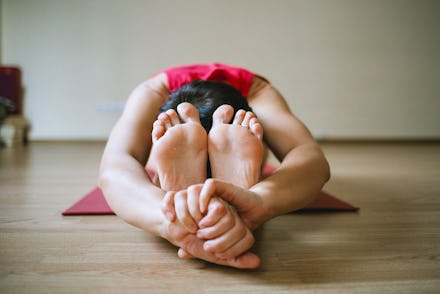Here's Why Yoga Mats Are Hella Gross and Why You Should Avoid Borrowing Them

The yoga craze is alive and well; walk through any urban environment these days and you're bound to literally bump into a neon yoga mat — or five. After all, there are a host of benefits to regularly practicing yoga, from athletic perks like better core strength and flexibility, to mental benefits like better focus, sharper cognition and less stress. In short: yoga enthusiasts are zen.
What isn't quite zen is all the microbes crawling all over your yoga mat.
Read more: Pretty Much Everything You Touch in the Gym Is Gross and Infested With Germs
Dr. Robert Lahita, a professor of medicine at the University of Medicine and Dentistry in New Jersey, spoke to Elle and summed it up best: "Yoga mats are the worst."
Lahita, who has a background in infectious diseases and a PhD in microbiology, continued to describe yoga mats as a "perfect incubator for many of our skin infections," as well as a "fertile source for infection" primarily due to all their contact with sweat — and little time with a sponge and disinfecting soap.
Lahita explains that yoga mats are "fomites," a biological term referring to any inanimate object susceptible to spreading infection. These infections include ringworm, staph infection and athlete's foot. Exacerbating your susceptibility to these maladies is the fact that you're more than likely to be barefoot when practicing yoga, which means more skin contact with a contaminated surface.
And that's just personal yoga mats; communal yoga mats you may borrow in a bind during a group class will have more contact with sweat become even more of a germ-fest — worse yet if you're grabbing communal yoga mats used in a hot yoga class.
In 2006, a New York Times article noted hygiene policies vary from chain to chain, and that hygiene isn't usually the top priority when it comes to gym equipment due to expense and labor (or many chains put the responsibility on the users, which basically means they remain uncleaned).
How can you shield yourself from this super un-zen nastiness? For one, avoid borrowing any loaner mats or only borrow a yoga mat from someone whose hygiene you can confirm.
Or better yet: buy one of your own and keep a good routine of keeping it clean. In short: if you smell the funk, it's time to wipe it down. Being observant of wear and tear is also wise as holes and crevices means more places where germs can bury themselves into – or rather, that it's harder to disinfect when you do finally give your yoga mat a wipe down. Finally, practice some common sense on when "wear and tear" is simply "worn and torn" and replace your mat when need be.
Namaste.